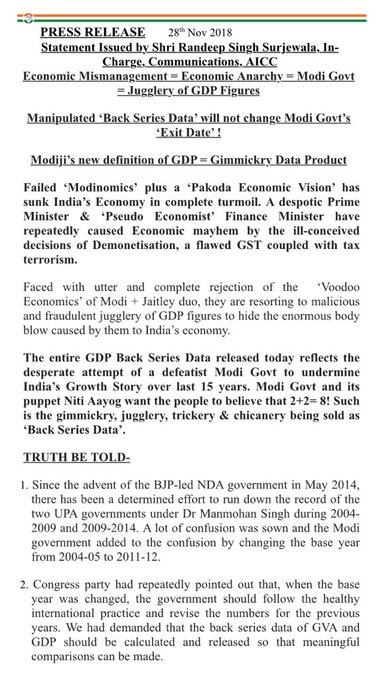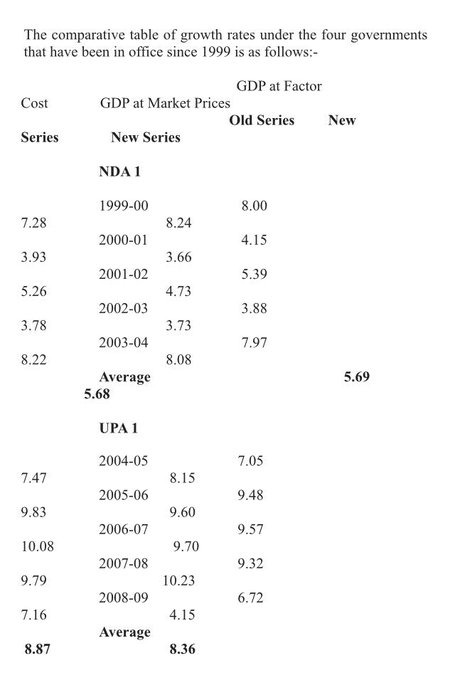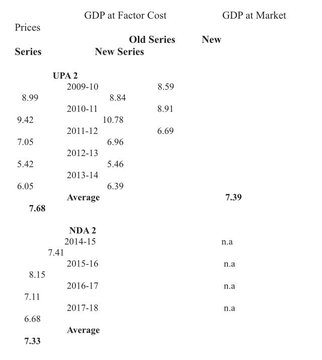The new figures show a lower rate of growth during the UPA years between 2005-06 and 2011-12 than what was estimated using the previous methodology.

HIGHLIGHTS
- The new figures were part of the back-series estimates for India's GDP
- Back-series estimates basically changes the base year for GDP estimates from 2004-05 to 2011-12
- Congress said it's a malicious jugglery to hide Modi govt' wrongdoings
The Niti Aayog on Wednesday revised the GDP figures of the UPA government led by former Prime Minister Manmohan Singh and reduced the record 10.3 per cent growth in 2011 to 8.5 per cent.
On Wednesday, the central government released the much awaited back-series estimates for India's Gross Domestic Product (GDP). The figures show a lower rate of growth during the UPA years between 2005-06 and 2011-12 than what was estimated using the previous methodology.
The Central Statistics Office (CSO) has said that according to new estimates, the maximum growth rate during the UPA years was achieved in 2010-11 when the economy grew by 8.5 per cent. The growth for this financial was earlier estimated to be 10.3 per cent.
Explaining the new estimates, Niti Aayog vice-chairperson Rajiv Kumar said the new figures are based on an extensive recalibration exercise that used latest data sources and methodological changes.
He said the back series had been checked for its methodological soundness by leading statistical experts in the country during two round tables organised by the Niti Aayog. During these, domain experts participated to ensure the quality of coverage and methodology.
In January 2015, the government had moved to a new base year of 2011-12 from the earlier base year of 2004-05 for national accounts.
After introduction of the new series, back-series estimates are compiled and released for the years preceding the new base year for completeness and comparability with old base data sets.
Malicious and fraudulent jugglery, says Congress
Meanwhile, responding to the new GDP estimates, the Congress rubbished the new figures and said this was nothing but a "malicious" attempt by the Modi government to cover its own wrongdoings.
"They [PM Modi and Finance Minister Arun Jaitley] are resorting to malicious and fraudulent jugglery of GDP figures to hide the enormous body of blow caused buy them to the economy of India," the Congress said in a statement.
New GDP growth figures
As per the data released by the CSO, growth rates for all years between 2005-06 and 2011-12 have been revised downwards -- to 7.9 per cent in 2005-06 (from 9.3 per cent); 8.1 per cent in 2006-07 (from 9.3 per cent); 7.7 per cent in 2007-08 (from 9.8 per cent); 3.1 per cent in 2008-09 (from 3.9 per cent); 7.9 per cent in 2009-10 (from 8.5 per cent); 8.5 per cent in 2010-11 (from 10.3 per cent); and 5.2 per cent in 2011-12 (from 6.6 per cent).
The growth rate for the years after the new base is estimated to be 5.5 per cent (2012-13), 6.4 per cent (2013-14), 7.4 per cent (2014-15), 8.2 per cent (2015-16), 7.1 per cent (2016-17) and 6.7 per cent (2017-18).
"CSO today released the back series of GDP/GVA for period 2004-05 to 2011-12 with base 2011-12 prices. We used SNA 2008 (United Nations System of National Accounts) concepts, latest data sources and indices for the back series. Methodological changes include institutional approach, reference rate method for FISIM (Financial Intermediation Services Indirectly Measured)," the NITI Aayog vice-chairperson said.
He added: "Treatment of trade sector (has been done) using sales tax instead of Gross Trading Income (GTI). Shares of primary and secondary sectors (has gone) up in the back series, while tertiary sector (has) reduced."
Source:https://www.indiatoday.in/business/story/modi-govt-revises-upa-gdp-figures-manmohan-singh-1398395-2018-11-28










No comments:
Post a Comment